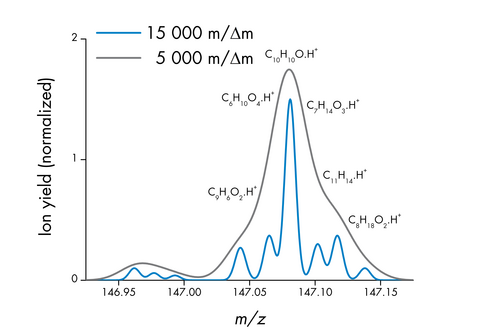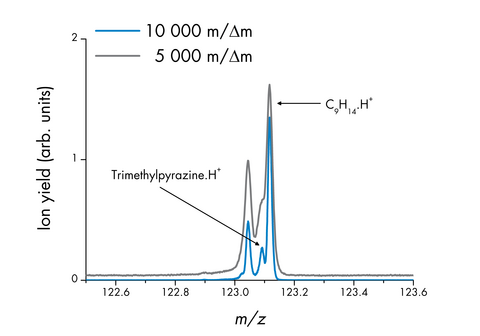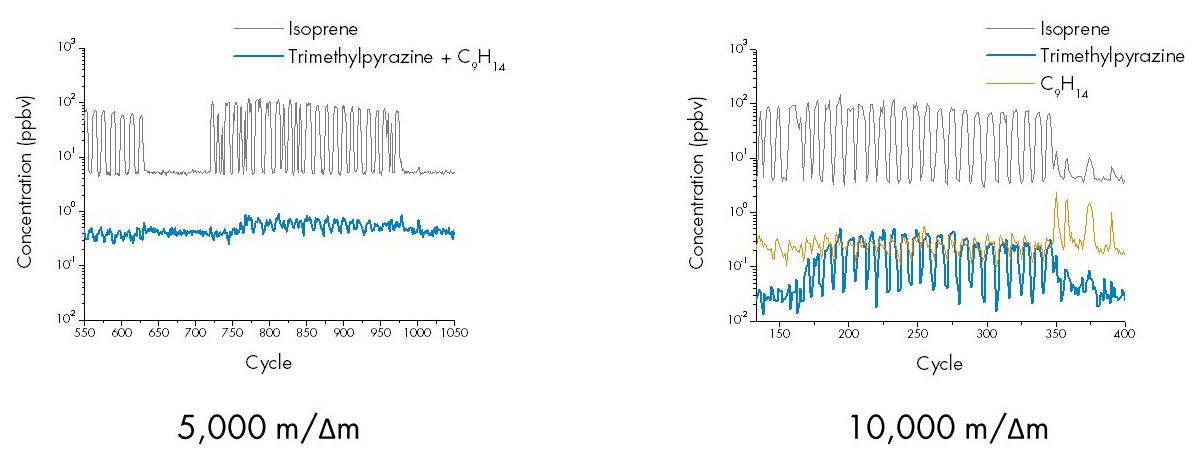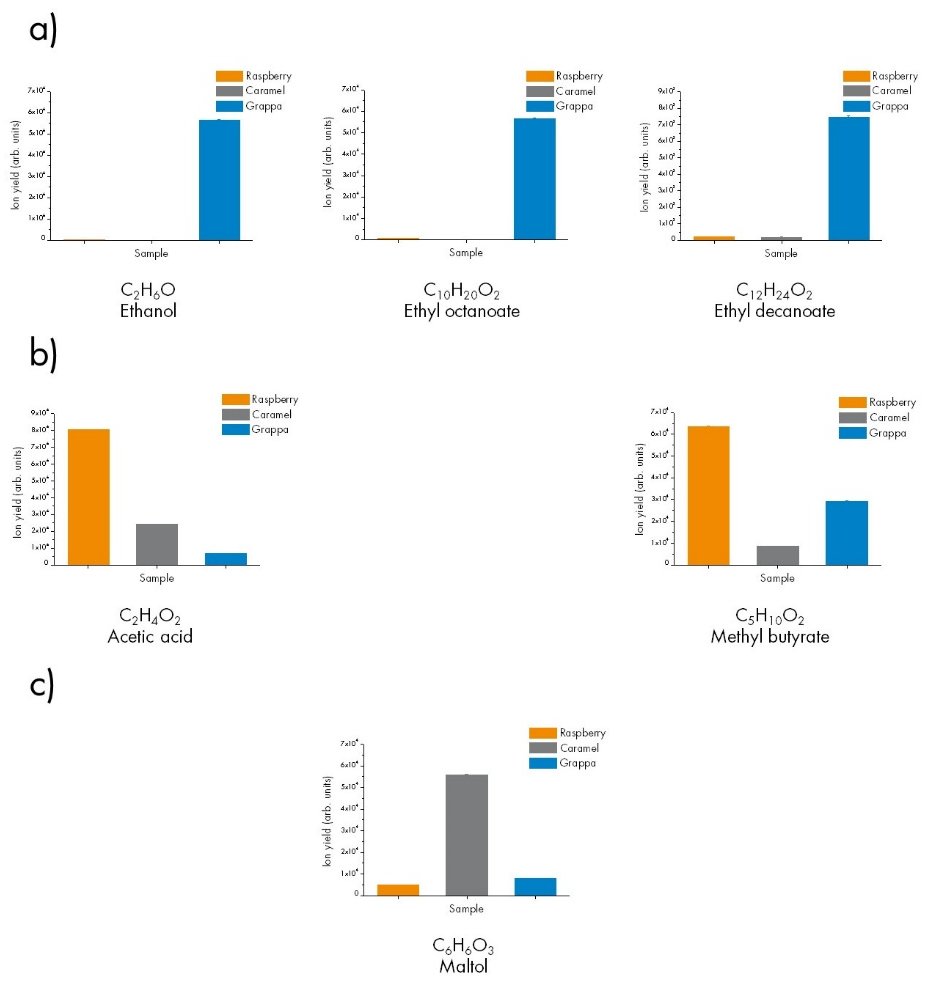PTR-MS is regularly used to explore the food chemistry of chocolate. Therefore, this application is predestined to demonstrate the amazing benefits of IONICON's latest instrumental developments, which have been found to take PTR-MS to the next level.

Image Credit: IONICON Analytik
More Resolution, More Selectivity
Both the PTR-TOF 10k and the Next-Gen FUSION PTR-TOF 10k offer a mass resolution ranging from 10,000 to 15,000 m/Δm.
This heightened level of analytical intricacy is exemplified by considering the nominal m/z 147 in the mass spectrum following the ingestion of salt-caramel-flavored chocolate.
Whereas merely two somewhat "altered" peaks were previously observable, the implementation of very high mass resolution allows the separation and effortless identification of no fewer than nine distinct peaks.
Significant aroma constituents such as benzalacetone (C10H10O) and butyl lactate (C7H14O3) are among the resolved isobars, along with metabolic and ambient air compounds.
However, the most pivotal advantage becomes readily apparent when analyzing the chocolate flavor within the intricate matrix of the olfactory space. Trimethylpyrazine (C7H10N2; protonated m/z 123.092) garners the utmost interest, given its status as a primary aroma compound in cocoa and chocolate.
The isobar C9H14 represents an omnipresent VOC, detectable at substantial concentrations in indoor air. At a resolution of 5,000 m/Δm, these two molecules are scarcely distinguishable, whereas, at 10,000 m/Δm, two distinctly separate peaks emerge in the mass spectrum.

Image Credit: IONICON Analytik

Image Credit: IONICON Analytik
The compound quantification capabilities are significantly impacted by this factor: Utilizing an instrument calibrated to 5000 m/Δm enables measurement solely of the combined concentration of trimethylpyrazine and C9H14.
Amid the blank nasal exhalations (cycles 550 – 650; exhalations marked by the isoprene signal arising from human metabolism), this total concentration fluctuates around several hundred pptv.
Upon ingestion and initiation of chocolate chewing around cycle 750, there is a minimal alteration in the signal behavior. It is not clear if trimethylpyrazine is released into the nosespace at all.
With the PTR-TOF 10k, which enables independent quantification of the two isobars, the concentration of trimethylpyrazine in the empty nasal space (up to cycle ~150) measures approximately 20 pptv — indicating that the C9H14 signal from ambient air does not mask it.
Consequently, the release of trimethylpyrazine into the nasal space can be meticulously tracked with sub-second temporal precision.
Upon the test subject's removal of disposable nasal pieces from the utilized NASE interface at cycle 350, the likely source of C9H14 emission becomes apparent — it is most likely a constituent of the subject's hand lotion, as only the orange line corresponds to the vicinity of the hand to the sample inlet.

Image Credit: IONICON Analytik
More Sensitivity, More Speed
The FUSION PTR-TOF 10k surpasses conventional PTR-MS devices, exhibiting an impressive sensitivity of up to 80000 cps/ppbv. This exceptional sensitivity proves vital in food and flavor research, particularly when time constraints heavily restrict each measurement's duration while upholding the need for high-quality data output.
To demonstrate this assertion succinctly, the team of scientists set up a challenge to see if the FUSION PTR-TOF 10k is able to definitively discern the flavor profile of a segment of chocolate by examining its headspace at room temperature for merely 1 second.

Image Credit: IONICON Analytik
The following marker compounds were chosen to represent distinct chocolate flavors:
Grappa (grape-based brandy)
- Ethanol: C2H6O, alcohol
- Ethyl octanoate: C10H20O2, found in wine
- Ethyl decanoate: C12H24O2, found in grapes
Raspberry
- Acetic acid: C2H4O2, sour taste
- Methyl butyrate: C5H10O2, berry aroma
Caramel
- Maltol: C6H6O3, caramel aroma
The outcomes exceeded the projections, displaying ion count rates in the range of 104 and beyond, following just 1 second of integration.
This leads to relative errors of less than 1%. While the graphs incorporate error bars, they are barely perceptible due to their insignificance. Hence, measurement durations in the millisecond range would suffice for exceptional data quality.
The FUSION PTR-TOF 10k masterfully conquered the somewhat whimsical challenge, demonstrating its prowess. However, a more serious implication of this achievement lies in the potential for high-throughput analysis of substantial food headspace volumes utilizing an autosampler to ensure impeccable data quality.

This information has been sourced, reviewed and adapted from materials provided by IONICON Analytik.
For more information on this source, please visit IONICON Analytik.